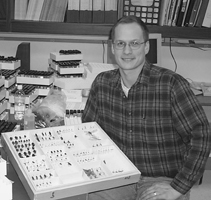Collection History

The Insect Collection is the museum’s youngest. It was started with NSF support (DEB-9981915)
in the year 2000 under direction of interim Curator James Kruse and built from three
large accessions of Alaskan specimens: ~ 100,000 specimens of Alaskan aquatic insects
(Ephemeroptera, Odonata, Plecoptera, Trichoptera, etc.) stored in glass vials and
preserved in ethanol, ~30,000 biting fly specimens (mostly Culicidae and Simuliidae)
on pins and in vials of alcohol collected mostly by K. Sommerman during the Northern
Biting Fly survey of 1947-1956, and ~75,000 pinned terrestrial insect specimens collected
between 1940 and the mid 1970s, mostly by Richard Washburn, for a US Department of
Agriculture collection in Palmer, Alaska.
This last collection has the greatest taxonomic breadth of the three with specimens
from all orders found in Alaska, including some rarities (e.g. Archeognatha). Smaller
subcollections are also present, including 24 Schmidt boxes of primarily bee (Apidae)
voucher specimens.
These accessions were in cabinets dating to the age of the specimens themselves. The
majority of Alaskan insect taxa are currently missing from the collection (so we are
eagerly seeking donations, especially of material already identified). A species-level
inventory of the collection has been completed. Most taxa requiring greater technical
skill to collect and prepare, such as the majority of small (<5mm) wasps and beetles,
are greatly underrepresented in the collection. This generalization does not apply,
however, to the biting fly specimens in the accession of K. M. Sommerman’s collection
– she was meticulous in mounting with minuten pins very large series of well prepared
fly specimens.
Dry, pinned insect specimens were stored in the collections range in 12 aging metal
cabinets placed inside the compact mobile storage system. These cabinets held 150
wooden glass-topped drawers of a make and dimensions no longer manufactured. Specimens
were stored in hard-bottomed unit trays inside these drawers.
The wet specimens, stored in glass vials containing ethanol, were held in cardboard
trays inside cardboard boxes that were stacked on top of the dry specimens. All wet
specimens have since been moved to the museum’s new alcohol storage room onto open
metal shelving.
Major Donations Cataloged to Date
USDA Palmer Research Station [1915 - 1988] >13,600 specimens cataloged,
USDA Agricultural Research Service, Subarctic station [2002-2011] > 30,000 specimens cataloged
USFWS Kanuti National Wildlife Refuge [2003-present], >13,000 specimens cataloged
Dominique Collet private collection [1990-2009] >13,000 specimens cataloged
